I think I might have taken too much time off during the holidays, and after a few days, decided I needed a new project to tackle. When it comes to hobbies, people typically partake in them as a source of enjoyment and relaxation. For me, one of my hobbies involves different aspects of technology. Depending on where my wondering mind takes me, it might be computer programming, tinkering with some aspect of electronics, home automation, or a combination of these as I work on a project.
If a hobby is suppose to be a source of enjoyment and relaxation, one thing I discovered when it comes to technology as a hobby… it sure has a way of bringing out colorful four-letter words and promoting frustration. However, the enjoyment and relaxation is eventually experienced when the intended end results are achieved.
In my current home I’ve incorporated various home automation features, and as I go through the mental exercise of planning for my next home, there are aspects of it that I will do differently. I’ve also identified additional functionality I would like to include. In a way, I’m using my current home as a type of home automation research and development lab for my next home… and with that, also comes the relaxing frustrations.
Over the past few weeks I’ve tackled a couple of automation projects. One involved determining if the garage door was open or closed, and defining conditions to automatically close it if open. The other involved notifying my home automation system if a smoke or CO2 detector alarm is triggered.
Incorporating the smoke / CO2 detectors was the simpler of the two projects. It merely involved connecting a Z-Wave wireless relay transmitter (Zen51 LR) to one of the detectors. The nice thing about this relay transmitter is that it is capable of differentiating between the alarm signal for smoke verses CO2. Once installed, I incorporated the relay with my home automation controller and was able to define rules to trigger events should any of the alarms detect smoke or CO2. For instance, if triggered, I disable the HVAC system, you don’t want it sending smoke / CO2 throughout the house, plus fire feeds on oxygen so why feed it more. I also turn on all the lights, and flash the exterior lights so first responders can easily identify the house. There are other rules based on whether I’m home or not, the security alarm status, etc.
Local code requires that all of the smoke / CO2 detectors be interconnected so when one is triggered, all of them go off. Makes perfect sense from a safety perspective. Unfortunately, this configuration doesn’t allow you to identify which detector triggered the alarm very easily. It is possible, but would require multiple relay transmitters and modifications to the wiring. I’m not concerned with identifying where specifically as much as ensuring anyone inside can get out safely. By incorporating the smoke / CO2 detectors with my home automation, I’m able to provide some additional safety features I otherwise couldn’t.
Automating the garage door was a bit more involved. Many of the newer garage door openers claim to be “smart home” enabled, but often end up providing limited functionality and use proprietary technology. Some even require you buy additional components or pay for monthly services. This was the case with my garage door opener. Initially, I intended to incorporate a Z-Wave wireless relay (Zen51 LR) that would simulate pressing the wall mounted garage door opener button.
I got the Z-Wave relay and wired it in with the garage door motor unit and added the relay to my home automation controller. At this point, everything looked good, but when I went to test it… nothing happened. Back to the garage and up the ladder to double-check and triple-check the wiring… everything looked good, so why wasn’t it working? From my automation controller I was able to test and confirm that the Z-Wave relay was detected, and receiving and responding to signals…. so what the what?! At this point, I turned to the oracle… Google and began searching for possible solutions. Eventually the all knowing Google bestowed upon me the knowledge that led me to the solution…
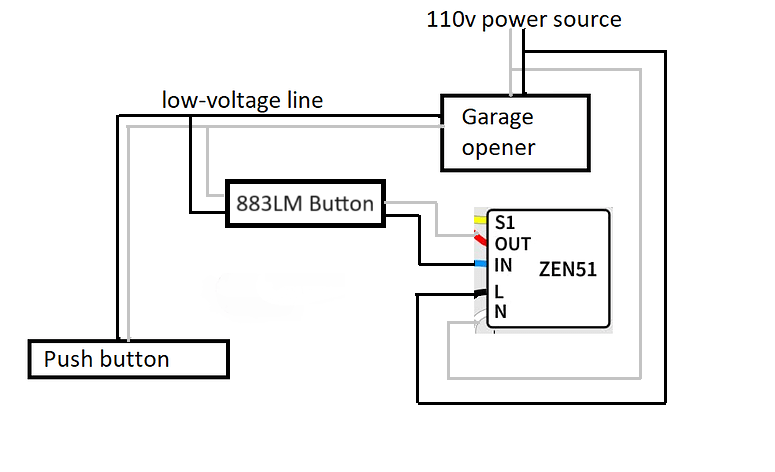
It turns out despite being hard wired, my garage door opener utilizes a proprietary signal between the opener button and the motor unit. In order to get around this, I would need to add another opener button between the Z-Wave relay and the motor unit. By doing this, the second opener button and relay “tricks” the motor unit into thinking the opener button has been pressed, which sends the proprietary signal to the motor unit. I was able to find a compatible opener button on Amazon (LiftMaster 883LM), so I was back in business with this project once it arrived.
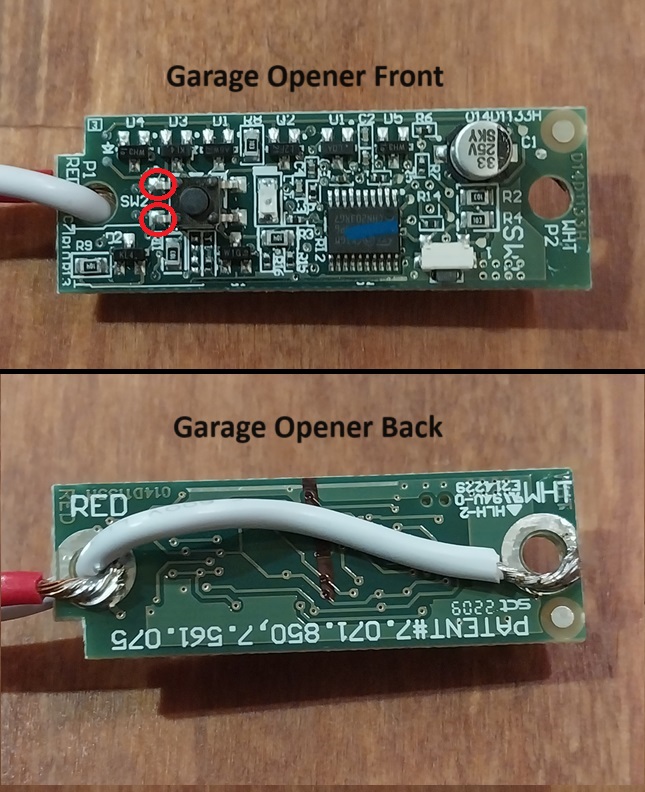
To make this work, I needed to remove the circuit board from the button housing and soldered some wires. On the back of the circuit board I soldered a red and white wire to the screw post holes where wires would be attached if wall mounted. These wires provide low voltage power to the button from the motor unit. Next, two wires were soldered to the pins of the small button (red circles on image), that when pressed, completes the circuit and sends the low voltage signal to the motor unit. These wires get connected to the In/Out leads on the Z-Wave relay.
With the soldering done, I then placed the modified circuit board into a small project box in order to protect it and isolate it from the Z-Wave relay. Next, everything was placed into an electrical box with power to the Z-Wave relay coming in from one side and the wires to the motor unit going out the other.
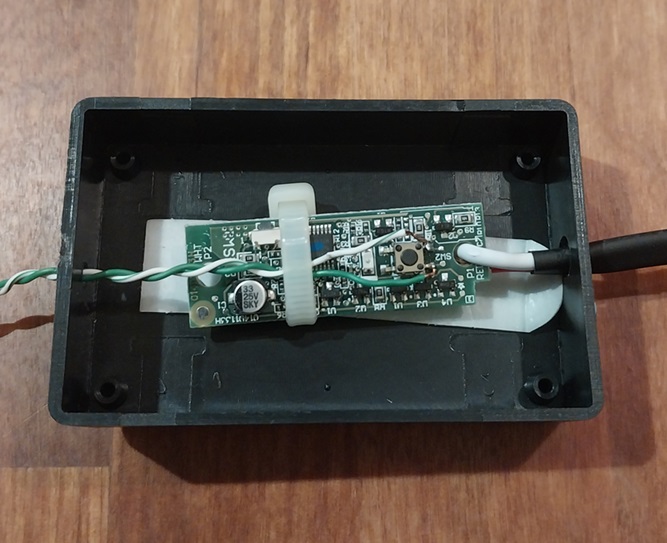
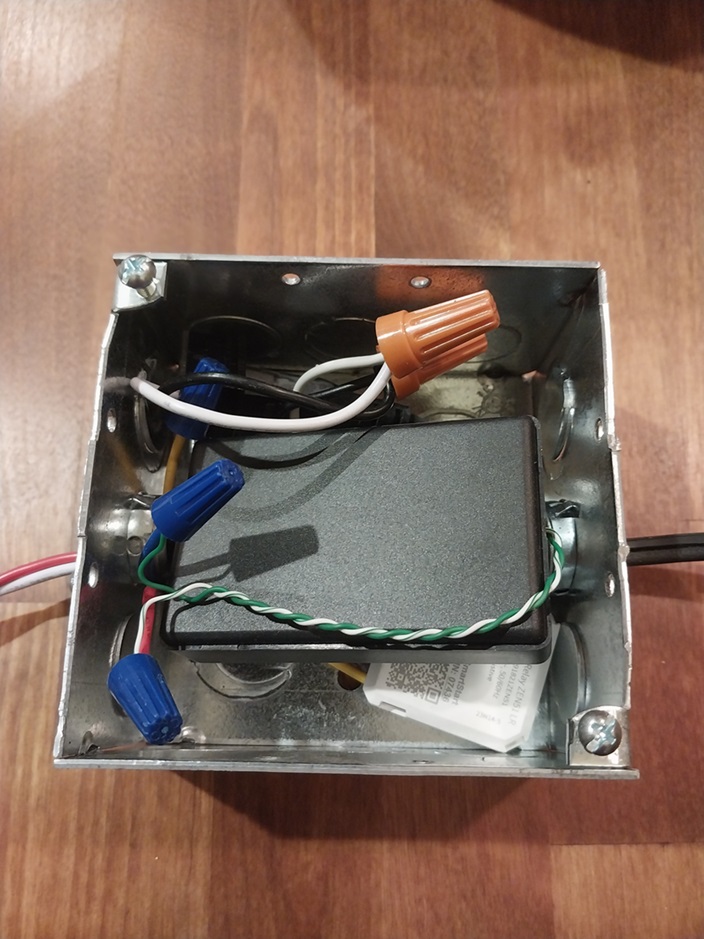
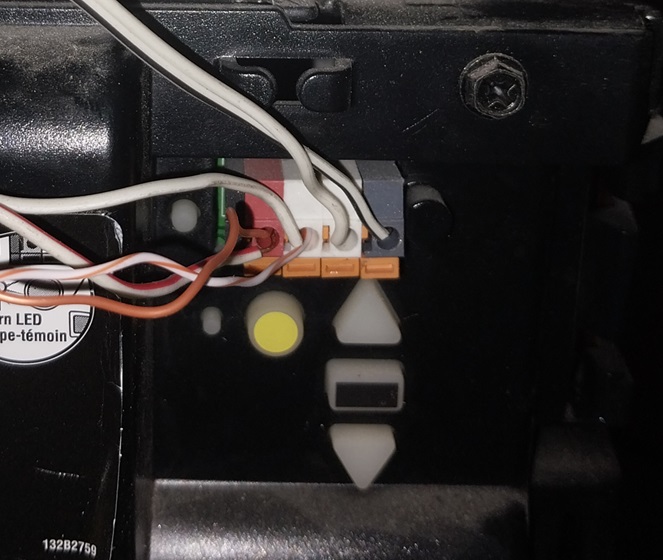
With everything finally together, it was time to wire it to the motor unit. Because I didn’t want to lose the ability to control the garage door from the wall mounted button, I combined the wires from the modified circuit board with the wires from the wall button.
Now for the moment of truth, back inside to the automation controller, trigger the relay and see if it works…. and it was a big bag of nope. Back out to the garage and up the ladder for what seemed like the 20th time.
My suspicions were telling me that whatever was preventing it from working was most likely isolated to the circuit board. I wanted to make sure I didn’t booger something up when I soldered the wires to the small button pins, so I used a jumper wire to short the button pins where I soldered the wires. When I did, the garage door opened, so the circuit board was still good.
Upon further examination, I discovered that one of the wires I soldered to the button pin was making contact with the metal housing of the small button. This was preventing the circuit board from receiving the signal from the relay when triggered. This was an easy fix once I figured it out. With the wire now insulated, another trip back to the garage and up the ladder for the final install, it was time to test… again.
Triggering the relay, I was serenaded by the sounds of the garage door motor. Success! Now with the Z-Wave relay working, I had another issue to solve. I needed a means of determining if the garage door was open or closed. Let’s say I wanted an automation event that would ensure I didn’t leave the garage door open when I armed the security system. The problem is without knowing the status of the garage door, I could inadvertently open the garage door when arming the security system. Solving this issue was relatively straight forward… place a tilt switch on the garage door. I picked up a Z-Wave tilt switch and placed it vertically on the top panel of the garage door. Now the automation controller receives status updates whenever the position of the garage door changes. I’m now able to create rules that control the positioning of the garage door. For example… ‘whenever the security system is armed to any state (instant, away, vacation, etc.), and the garage door status is ‘open’, then trigger the garage door relay.’ In this example, when the security system is armed, if the garage door status is ‘closed’, no signal will be sent to the garage door relay.
Having relaxed with only some mild frustration, I’m already pondering other projects. I’ve been considering adding a weather camera to my home weather station, and then post the information online. This project would definitely fall into the “just because” category since a weather camera wouldn’t add any real value unlike the weather data I’m currently monitoring. Let’s see where my project curiosity takes me….